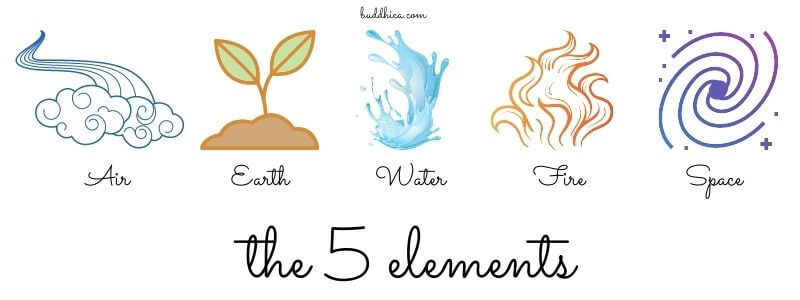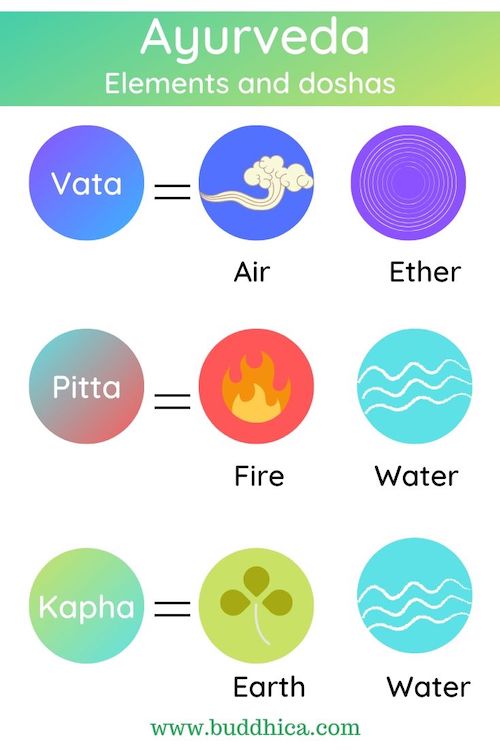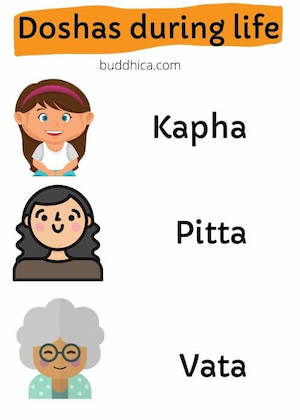In Ayurveda, doshas or mind-body constitutions are the basis of life. Ayurvedic doshas define your individual mind-body constitution and your affinities in life. A basic understanding of Ayurvedic doshas can help you identify personalized food, lifestyle, and even career choices. life.
These doshas can identify if you are susceptible to a particular disease. Understanding of doshas makes it easier for everyone to learn Ayurvedic self-healing and home remedies.
So exactly are Ayurvedic doshas, where do come from, and how they affect our bodies and minds? I will answer all these questions one by one. But before that, we need to understand what Ayurveda is and what are the five elements of nature.
What are the five elements in Ayurveda?
Ayurveda is a cohesive system of medicine that takes into account your body, mind, and soul. According to Charak Samhita, one of the first books on Ayurveda, healthy life is the one where your body is disease-free, active, stable, your mind is free of greed, lust, envy.
Ayurveda is based on the concept of 5 core elements- Air, water, fire, earth, and space. According to Ayurveda, our entire universe is made up of these 5 basic elements.
Humans are a part of the same creation and thereby share these 5 elements as well. These 5 elements are known as Panchamahabhuta (Five Great Elements). These five elements have different functions in nature as mentioned in Charaka Samahita.
| Elements | Characteristic | Inherent function |
| Air | Mobility | Touch |
| Water | Liquidity | Taste |
| Fire | Heat | Vision |
| Earth | Roughness | Smell |
| Space | Free flow | Sound |

These five elements in different proportions create different entities. These 5 elements are responsible for the formation of ayurvedic doshas as well.
It is the ratio of these five elements in the body that defines the dominant dosha in your body. The signs of increase or decrease of these features in the body are observed and applied in the prognosis and diagnosis in Ayurveda.
What are the three Ayurvedic doshas?
These 5 elements give rise to tridosha’s or three Ayurvedic doshas- Vata, Pitta & Kapha. Ayurveda studies all the activities (normal & abnormal) in the human body with respect to these three doshas or tridosha.
The doshas form the general outline of the constitution of an individual. Based on doshas we can study the body’s physiology, digestion, assimilation, absorption, and elimination.
Understanding your ayurvedic doshas gives a good inference of your psychological strengths and weaknesses, mental strengths and weaknesses, and susceptibility to illnesses.
Vata- Air + Space
Vata dosha is a combination of air and space. It is the most important dosha in the body. Vata dosha governs all the movements in the body including locomotion, movement of fluids, transfer of information, and movement of waste. Vata dosha also helps in cell division and growth.
There are 5 types of Vata dosha,
- Prana Vata – Located in the brain, head, throat, heart, and respiratory organs. Governs inhalation, senses, emotions, and musculoskeletal functions.
- Udana Vata – Located in the navel, lungs, and throat. Governs voice, speech, self-expression, effort, and vitality
- Samana Vata – Located in the stomach and small intestines. It allows food to move from the food pipe to the stomach and then to the intestines.
- Apana Vata – Located between the navel and the anus. It governs all downward impulses like urination, elimination, menstruation, and sexual appetite.
- Vyana Vata – Centred in the heart and pervades the whole body. Responsible for heart-related functions like circulation and heart rhythm.
Pitta- Fire + Water
Pitta is the dosha that corresponds to fire in the body and represents metabolism. Pitta is the heat energy in the body and allows for all digestive functions in the body.
The fire and the water elements in perfect combination result in a strong digestive system, glowing skin, and a good appetite.
There are 5 types of pitta doshas,
- Pachaka Pitta – It is located in the lower stomach and small intestine. It governs the digestion of food into nutrients and waste.
- Ranjaka Pitta – It is located in the liver, spleen, and gallbladder. It is responsible for the formation of red blood cells ad imparts color to them.
- Alochaka Pitta – It is located in the eys and governs vision.
- Sadhaka Pitta – Located in the heart, it governs memory, intelligence, and emotions.
- Bharajaka Pitta – It is located in the skin and gives color and luster to it.
Kapha- Earth + Water
Kapha is the Earth and the water element combined. In our bodies, Kapha energy closely represents mucus or phlegm. The function of mucus in the body is to hold everything together and allow smooth movements in the body.
It provides softness, sturdiness, lubrication, and cohesiveness in our bodies. It is the most dominant energy in children during their formative years. The five types of Kapha are,
- Shleshaka Kapha – Is located in the joints and governs lubrication.
- Avalambhaka Kapha – Governs lubrication in the spine and provides strength to the back, chest, and heart.
- Tarpaka Kapha – Located in the head, nostrils and cerebral fluid, this governs our state of mind and satisfaction in life.
- Bodhaka Kapha – This governs the taste and lubrication of food in the mouth.
- Ledaka Kapha – Located in the throat and upper stomach. It liquifies and moistens food before it reaches the stomach for further digestion.
In Ayurveda, doshas are of great importance in maintaining optimum health and vitality. It is like your personal guide to living a healthy and fulfilled life. Most illnesses in the bodies occur due to imbalance in these doshas. Simple knowledge of their dominance, functionality, their state at a given moment can prevent diseases and restore health efficiently.
How does a person acquire Ayurvedic doshas?
We have mentioned earlier that 5 elements of Ayurveda are the basis of everything in this universe. This is true for every human as well. Every person is born with a varying constitution of these 5 elements and their subsequent doshas.
This constitution at the time of your birth is your Prakriti or your basic constitution.
This means that a person’s mind-body constitution or doshas are predisposed at the time of conception, pregnancy, and birth. At the time of conception certain factors like
1. quality of eggs and sperm
2. time of conception
3. the month of conception
4. weather
5. emotions during conception are responsible for the dosha constitution.
During pregnancy, the doshas are still forming and depend on the external environment, food that the expecting mother eats, family bonding, and the types of thoughts that the mother thinks are all responsible for the dosha predominance.
The doshas that attach at the time of birth becomes the body’s constitution or Prakriti of that person. The mind-body constitution of a person can be dominated by one dosha, two-doshas (bi-doshic) or all three doshas equally(tri-doshic).

What does dominant dosha mean?
Though there are only three Ayurvedic doshas, the combination of these three doshas give rise to 7 different mind-body constitution or Prakriti types,
Vata- one who’s dominating dosha is Vata
Pitta- one who’s dominating dosha is Pitta
Kapha- one who’s dominating dosha is
Vata-Pitta or Pitta-Vata- One who has two dominating doshas Vata & Pitta
Vata-Kapha or Kapha-Vata- One who has two dominating doshas Vata & Kapha
Pitta-Kapha or Kapha-Pitta- One who has two dominating doshas Pitta & Kapha
Vata-Pitta-Kapha- One who is dominated by all three doshas (all three doshas in equal ratios) Doshas are inherently in the state of equilibrium but they have a tendency to vitiate or get imbalanced.
This can happen due to various reasons including diet, climate, lifestyle, and emotional health. When these doshas vitiate, they influence the respective elements in their constitution as well.
These elements are connected to different functions of the body. When the elements get vitiated it results in the state of disease. In the body, Vata corresponds to air, Pitta corresponds to digestive fire and Kapha corresponds to the mucus.
Each dosha has an important role to play. When one or more doshas are out of balance your body becomes susceptible to diseases. Because of the combination of doshas, characteristics are found accordingly in everybody.
In people having an equilibrium of all doshas, the character of all of them is found equally.
Do I have only dominant doshas in the body?
Most people are confused if they have all three doshas in their bodies or just the dominant ones. What does it mean to be a Vata dominant for example? Do you then not have Pitta and Kapha in your body?
Let’s go back to the 5 elements. We have already established that every individual is a contribution of these 5 elements in different ratios.
So yes we all have all three doshas in our bodies at any point in time. Every dosha is responsible for a function in the body and is dependent on the other dosha as well.
So if you are a Vata dominant, it means that your body’s natural constitution is made up more of air and space elements. But you also have Pitta and Kapha in varying quantities.
Characteristics of Ayurvedic doshas
Vata
Vata, the combination of air and ether is the most important of the ayurvedic doshas. Vata dosha maintains movement in the body. It is responsible for agility, strength, happiness, and also life force or Prana. Vata is basically air or Vayu.
Vata controls the movement of the other two doshas as well. Air supports our entire planet, our breath, the clouds, the rains, the proliferation of seeds or waves in the ocean, and cooling the Earth.
But when air is out of control, it causes hurricanes, tornados, devastation, fires, tsunamis, and churning of mountains. Similarly, the air has an important role to play inside your body.
It is the basis of life, your breath. It is responsible for the circulation of fluids inside the body, the movement of joints, and the movement of waste. It is responsible for speech and touch and maintains the emotions too.
It removes excess pitta from the body and maintains adequate moisture in the skin. Vata people have an affinity for a warmer climate as Vata dosha is cool. These people have cold hands and feet in the winter.
Their skin is usually dry and scaly. Vata people also have sloppy digestion and are prone to bloating, indigestion and gastritis. Vata people are dreamers and creatives and have a very fast mind.
They are constantly thinking about a lot of things simultaneously. When out of balance, Vata dosha people might face a lot of confusion and anxiety. Their speech might get distorted and their bodies become unstable.
It is important to understand here that Vata is air but a lot of it will make you feel bloated and engage in flatulence in the body. Apart from this, excess Vata in the body changes your complexion.
If you have lately realized your ashen complexion, it is because of the vitiated Vata. Vata people are sensitive to changes in weather. They also have a very sensitive digestive system.

Qualities of Vata
Dry, cold, light, subtle, mobile, non-slimy, and rough.
Vata Imbalance treatment
Vata is located in the body in mostly lower regions of your abdomen. It accumulates in the urinary tract, colon, waist, legs, bones, and intestines. Vata can be imbalanced by the food, environment, or emotions of a similar kind.
It accumulates in the rough, dry, and hollow parts of the body. Vata can be pacified by the opposite qualities like heaviness, oiliness, hotness, and smoothness. Yoga is especially beneficial for a Vata imbalance.
It is during yoga that you go deeper into the body and eliminate the accumulated Vata from the body. It also stabilizes your thoughts and emotions. Thus Vata moving in such body parts finds no place and as such gets pacified. Sweet, sour, and salty taste favors bring down Vata.
Oil is particularly helpful in managing excess Vata. Including it in diet or using oil for body massage is one of the ideal treatments for Vata.
Read the detailed guide on Vata dosha and how to balance it here.
Disorders that might affect Vata
Cracking soles, joint stiffness, pain in the abdomen, arthritis, insomnia, psychological disorders, bluish complexion, hemiplegia, dry and cracking skin.
Pitta
Pitta is fire or Agni. It is the force that is responsible for producing energy and burning excess or negative things off. In nature, fire is the creator as well as the destructor. Fire is the source of energy.
Controlled heat gives rise to the food we eat, supports the flora and fauna of the earth, controls the weather, and produces energy. When beyond control, it can devastate entire civilizations and make a place uninhabitable. Such is the function inside the body.
Pitta is the fire that regulates the combustion of food and the production of energy in the body. When balanced, the body has good digestion, glowing skin, prowess, and a logical attitude. When imbalanced, the excess heat in the body can cause inflammation and rashes on the skin, acidity, ulcers, and a lot of anger-related issues.

Qualities of Pitta:
Slightly dry, hot, sharp, liquid, sour, mobile, and pungent
Pitta Imbalance Treatment
Pitta is located in the body in sweat, lymph, blood, and the stomach. Pitta can be aggravated by excess sour, salty or pungent foods. It also aggravates when you are constantly stressed.
Consumption of ghee or clarified butter on a regular basis is one of the most important steps in managing pitta. Favor sweet, bitter, and alkaline foods.
Purgation or emesis using saltwater is one of the quickest and the most efficient way to balance pitta. Since pitta is located in your stomach, this process eliminates most of it quickly and your system detoxifies internally.
Read the detailed guide on Pitta dosha and how to balance it here.
Disorders that might affect Pitta
Hyperacidity, inflammation on the skin, herpes, urticaria, and anger issues
Kapha
Kapha has the qualities of both earth and water and together forms the protective mucus in the body. It is this sticky substance that provides moisture to the joints and binding and firmness in the body.
Kapha provides the first layer of protection against pathogens and dust. In nature, the earth provides grounding and keeps us rooted. Earth is a system that supports the growth of vegetation, holds the ecosystem together, and provides a breeding ground.
Similarly in the body, Kapha is the force of stability, strength, restraint, and knowledge. Kapha is essential to maintain lubrication in the body, to keep the skin soft and glowing. Kapha people are very calm and rational.
They are slow to react & respond and do not take rash decisions. They are very empathizing and are good listeners. When out of balance, the body can become excessively dry, heavy, and slow.
Excess Kapha can impair digestion and result in the accumulation of toxins in the body. The body becomes loose and muscle mass is reduced considerably.

Qualities of Kapha
Heavy, cold, soft, oily, sweet, immobile, slimy.
Kapha Imbalance Treatment
Kapha is located in the body in the head, joints, neck, stomach, fat, and especially in the chest. Excess Kapha can be balanced with flavors opposite to Kapha like pungent, bitter, astringent, sharp, and hot.
Kapha can be substantially reduced by emesis or Vamana. It can be done at home easily once a week to get rid of excess mucus or toxins from the body.
Another remedy for balancing Kapa dosha is breathing exercises or Pranayama- Kapalbhati and Bhastrika. They increase the heat in the body and fastens the metabolic process.
Doing 5-10 Sun salutations daily is a perfect way to activate your body. Honey is the best remedy for Kapha.
Read the detailed guide on Kapha dosha and how to balance it here.
Disorders that might affect Kapha
Diabetes, Obesity, congestion, goiter, blocked arteries, lethargy, and drowsiness.
How to identify Ayurvedic doshas in the body?
Though there are simple techniques to identify doshas, here are a few physical methods to identify dosha changes and imbalances in the body.
Pulse Reading
Your pulse can tell you so many things going on in your body. In Ayurveda, a pulse diagnosis can help you understand how your doshas and tissues are reacting.
Anyone can learn this simple method to see how fluctuation happens throughout the day according to the dominant dosha during the phase. Or they can use this method to identify imbalances (Although a second opinion with a consultant should be done to confirm).
Simply put your first three fingers on the wrist of the other hand. The other hand should be slightly loose.
The position of the first finger denotes Vata placement, second pitta, and third Kapha
In this method, apply slight pressure with your fingers on the wrist. Identify which finger is feeling the pulse more. If you feel throbbing more in the first finger, your Vata dosha might be dominant.

The throbbing in the Vata finger will feel more like a serpent, going fast and smooth. The rate is 80-100 in Vata.
If Pitta is dominant, you will feel the pulse to be more like a frog, quick and jumpy. The rate is 70-80 in Pitta.
If Kapha is dominant, you will feel the pulse to be stable and steady. The rate is 60-70 in Kapha.
Eyes
Vata people have small eyes with drooping eyelids and dry. They have small and scanty eyelashes. The white of the eye is muddy, while the iris is dark, grey-brown or black.
Pitta’s eyes are moderate in size. They are sharp, gleaming, and sensitive to light. They have scanty lashes but they are moist. Their iris is reddish-brown or yellow-brown.
Kapha people have big, round, and beautiful eyes. Their long lashes make them even prettier. The white of the eye is very white, while the iris is pale, blue, or black.
Nails
Vata people have thin brittle nails. Their nails don’t grow much. If your nails have recently become brittle, check if your Vata is out of balance.
Pitta people have long but thin nails. They are soft and shiny. They are flexible and can bend easily
Kapha nails are strong, sturdy, and shiny. The nails look uniform. They grow fast and can withstand harshness.
Do only dominant doshas get imbalanced?
Any dosha in your body can vitiate even if it is not your dominant dosha. If you are a Vata dominant type, your pitta dosha can still go out of balance. But if your dominant dosha gets imbalanced, you will feel the changes more.
For eg., if a pitta dominant person’s pitta dosha goes out of balance they might get severe acid refluxes or rashes on the skin. But if a Vata person’s pitta goes out of balance they might only feel like a burning sensation in their stomach.
How to identify the imbalance of doshas?
These doshas can become vitiated by over-indulging in dosha favoring flavors or routines, for e.g., sleeping in late will increase your Kapha if you already are Kapha dominant.
Food also plays a key role in keeping your doshas in check. Your doshas can become vitiated if you eat incompatible food. In Ayurveda, there are a few basic rules of eating, and if you want to balance your doshas it is important to understand what is favorable and what isn’t.
Imbalance in doshas can be identified by observing oneself. Imbalance in your doshas can be seen clearly in your body and your mind.
| Dosha Imbalance | Physical symptoms | Emotional Symptoms |
| Vata | Always cold Can’t bear cool temperature,
Cold hands and feet Excessive dryness in the skin Excessive bloating or flatulence Cracking joints Nervous problems like sciatica Dandruff and dry scalp & hair |
Indecisive
Have a groggy concentration Anxiety and panic attacks |
| Pitta | Rashes, acne, boils on your skin
Burning in your chest or stomach Acid reflux Itching or excessive heat in the body Urge to drink cool beverages Premature hair greying Hunger pangs |
Getting angry
Irritated quickly Cranky Overly competitive |
| Kapha | Weight gain
Congestion Oily skin and pimples Excess phlegm formation Slow and lethargic body |
Lazy
Not ambitious Lethargy Averse of taking risks Averse of working hard |
How do doshas change during the day?
Doshas keep changing during the day based on the time. Every 24 hours in Ayurveda is divided into six parts consisting of 4 hours each. All these phases throughout the day are governed by a particular dosha.
Vata
Vata dominates from 2 am to 6 am in the morning and from 2 pm – 6 pm in the evening. It is recommended in Ayurveda to wake up during the Vata hours in the morning.
As Vata represents movement, it is the time when our body’s natural rhythm is to stay awake and move. In the evening, from 2 pm to 6 pm are your creative hours and you should use this time to come up with great ideas.
This time is also very high in prana (life) air and ether, also, known as Bhrama Muhurat or a time of great consciousness in Ayurveda. Yogis wake up early in the morning to utilize this time to practice meditation, yoga, and prayer.
Pitta
Pitta governs the time from 10 am to 2 pm and from 10 pm to 2 am. It is recommended in Ayurveda to take your heaviest meal before 2 pm. This is when the digestive fire is optimum and the sun is high.
Because pitta is the time for hard work and mental efficiency, you should utilize this time to make important decisions and completing your biggest task ahead.
At night, when the body is at rest, pitta governs digestion and assimilation of food. It allows your digestive organs to absorb nutrients from the food and get rid of the waste. Pitta helps in recovering the body at night.
Kapha
Kapha governs the time from 6 am to 10 am and then 6 pm to 10 pm in the evening. How many times have you found it difficult to wake up after 7 am in the morning?
Kapha is heavy and it makes you feel lethargic if you don’t utilize your Vata time effectively. Use your Kapha time in the morning to do heavy exercises like lifting weights as Kapha keeps your body sturdy during this time.
As Kapha is stable and calm, use this time to conduct important or complex conversations. You will be naturally calm during this time.
At night, Kapha is a signal to wind down and engage in relaxing activities. Sleep before 10 pm when the Kapha is highest. You will naturally drift off to sleep.
Seasonal influence on Ayurvedic doshas
Vata
Fall and winter is the season of Vata. The winds are cold and dry. This is the season when a Vata imbalance occurs in the body. It is advised to take a lot of hot soups, tea, coffee, herbal infusions, and warm cooked food during the Vata season.
This prevents Vata from accumulating in the body. Also, since during this season your body is cold and dry, it is important to include a type of workout in your routine even if it is home-based.
Yoga is ideal as it involves deeper muscles removing excess Vayu or air from the body. Massage with warm oil is also beneficial to keep the dosha in check and keep the body hydrated and moisturized. Eating ghee is especially beneficial during the Vata or the fall season.
Pitta
Pitta is aggravated during hot months and rainy season. During the hot months, the sun is at its peak and the temperatures are soaring. This results in an increase in body temperature too. During the rainy season, the chance of acid reflux increases, and inflammation increases too. Pitta season is the season of fire.
To balance fire in the belly, it is intuitive to eat cooling foods. Include salads and fruits in your diet. Eat light food during this season. Water-based vegetables like cucumbers, gourds are very good during this period of time.
Do not include cold drinks and ice-based drinks to cool your body. Instead, sip warm fennel tea or mint tea. It will cool you from the inside and balance excess pitta.
Kapha
Kapha season starts from late winter to spring season, i.e., from January to May. This season is cold and wet. It is during this season that the chances of infection increase and cold and flu become common.
It is the ideal time to eat fats. Fats are common in this season. Consuming dried fruits, nuts, seeds, ghee, etc. in your diet. Consuming hot and warm tea, herbal infusions are good for increasing metabolism. Since the temperature starts rising during this period, you can impart an outdoor workout in your routine.
Taking a walk in the park, running/jogging are some outdoor activities that will keep your heart pumping and help in balancing Kapha. Ginger is especially beneficial for a Kapha imbalance.

How doshas vary with age?
As with seasons, doshas vary with your age too. Each stage of your life is governed by one dosha. Doshas are energies and based on the requirement of the time, your doshas act accordingly.
Kapha
Kapha governs the formative years of a child. Since Kapha is the energy that binds your organs together and supports growth, it is the ideal requirement of the body during that phase.
Pitta
During our adulthood, Pitta is the dominant force in nature. It is because you need to work hard and achieve your goals during this time. These are the years where you can produce your best work because of the energy you have.
Vata
Vata is the primary force governing later years of your life. Vata kicks in from 50 years onwards. It is the time when you see increased cases of musculoskeletal issues in people. Because Vata is dry it increases dryness, wrinkles, and cracked joints in adults. Vata also governs your nervous system.
It is pretty common for people in this age group to experience issues with memory and control on their muscles. Problems like Dementia, Alzheimer’s, and Parkinson’s occur during this time.
Balancing Ayurvedic doshas with Panchakarma
Once you have identified your dosha or an imbalance in your body, the next step is to manage it efficiently. Read the detailed guides on each dosha to understand what balances your doshas.
Panchakarma treatment in Ayurveda is the ultimate cleanse which has the power to reset the body. It is a 5 step- detox that is used to release stored emotions and toxins in the body.
Read these guides here to understand what Panchakarma is and who should go for it.
The treatment varies in length based on the type of imbalance. For chronic disorders, it is usually longer (21 days)
It is the most powerful way to cleanse your mind and body and get rid of excess toxins from the body. You can look for Panchakarma centers near you or you can try a home-based Panchakarma first. This will give you a fair idea about how your body reacts to the treatment.
If you plan on taking a Panchakarma treatment near you or go on an authentic retreat, you can read these guides,
13 best Panchakarma treatment in the USA- With cost and ratings
15 places for best panchakarma treatment in India
A few more words on Ayurvedic Doshas
Now that you know what doshas are and how do they impact you, the next step is to find out what your dosha is. You can read the characteristics in this post to identify your dosha or you can consult with an Ayurvedic physician near you.
Knowing your Ayurvedic doshas give you a handbook of living your life close to your true self. It will allow you to define a lifestyle, routine, and food for you. You will understand why some things affect you more than others.
What is your biggest dosha challenge? Let me know in the comments below
Chakshu is a US alliance certified yoga teacher, a biotechnologist and an Ayurveda evangelist. Her passion is to help people live a toxic-free life, emotionally and chemically. She loves reading self-help books. When she is not writing, she is busy thinking about life.




